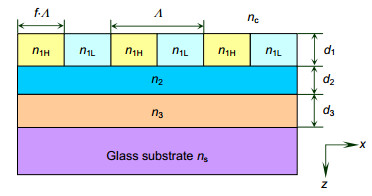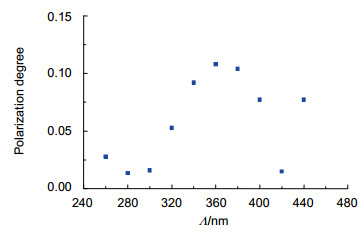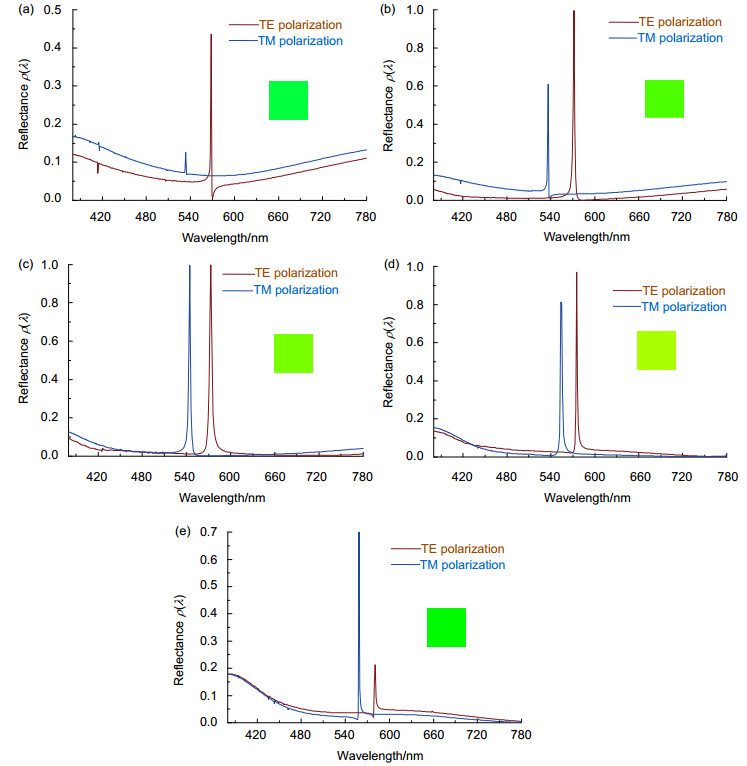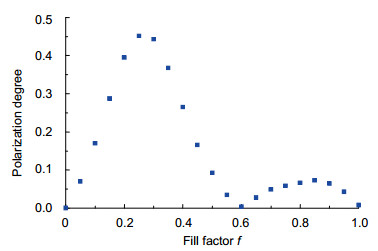| Citation: | Zhibin Ren, Yahui Sun, Jiasheng Hu, et al. Light polarization and color from guided-mode resonance filter[J]. Opto-Electronic Engineering, 2017, 44(11): 1052-1055. doi: 10.3969/j.issn.1003-501X.2017.11.003 |
Light polarization and color from guided-mode resonance filter
-
Abstract
The characteristics of reflected light of a 1-D guided-mode resonance filter (GMRF) are studied in this paper. A triple-layer GMRF is designed by using the finite difference time domain method under non-polarized light illumination. Numerical results show that the reflectance spectra of TE and TM polarizations can be changed by altering the fill factor f of the GMRF. Moreover, by calculating the color of the reflected light with the chromaticity theory, we find that the color of reflected light becomes pure when f is 0.9. The results show that the color and polarization degree of the reflected light of a GMRF are tunable by altering the fill factor.
-

-
References
[1] Katchalski T, Levy-Yurista G, Friesem A A, et al. Light modulation with electro-optic polymer-based resonant grating waveguide structures[J]. Optics Express, 2005, 13(12): 4645‒4650. doi: 10.1364/OPEX.13.004645 [2] Mehta A A, Rumpf R C, Roth Z A, et al. Guided mode resonance filter as a spectrally selective feedback element in a double-cladding optical fiber laser[J]. IEEE Photonics Technology Letters, 2007, 19(24): 2030‒2032. doi: 10.1109/LPT.2007.908776 [3] Vogel M M, Rumpel M, Weichelt B, et al. Single-layer resonant-waveguide grating for polarization and wavelength selection in Yb: YAG thin-disk lasers[J]. Optics Express, 2012, 20(4): 4024‒4031. doi: 10.1364/OE.20.004024 [4] Xiao Guohui, Zhu Qiangzhong, Shen Yang, et al. A tunable submicro-optofluidic polymer filter based on guided-mode resonance[J]. Nanoscale, 2015, 7(8): 3429‒3434. doi: 10.1039/C4NR07233B [5] Boonruang S, Mohammed W S. Multiwavelength guided mode resonance sensor array[J]. Applied Physics Express, 2015, 8(9): 092004. doi: 10.7567/APEX.8.092004 [6] Inoue J, Majima T, Hatanaka K, et al. Aperture miniaturization of guided-mode resonance filter by cavity resonator integration[J]. Applied Physics Express, 2012, 5(2): 022201. doi: 10.1143/APEX.5.022201 [7] Uddin M J, Magnusson R. Efficient guided-mode-resonant tunable color filters[J]. IEEE Photonics Technology Letters, 2012, 24(17): 1552‒1554. doi: 10.1109/LPT.2012.2208453 [8] Zhao Yali, Jia Kun, Zhang Han, et al. Transmission properties of metal photonic crystal films in visible light and microwave[J]. Opto-Electronic Engineering, 2017, 44(2): 226‒233. (in Chinese) [9] Sang Tian, Wang Yueke, Li Junlang, et al. Bandwidth tunable guided-mode resonance filter using contact coupled gratings at oblique incidence[J]. Optics Communications, 2017, 382: 138‒143. doi: 10.1016/j.optcom.2016.07.030 [10] Kinoshita S, Yoshioka S. Structural colors in nature: the role of regularity and irregularity in the structure[J]. Chemphyschem, 2005, 6(8): 1442‒1459. doi: 10.1002/(ISSN)1439-7641 [11] Hashimoto K, Yano T, Shimizu M, et al. New method for specifying color-rendering properties of light sources based on feeling of contrast[J]. Color Research and Application, 2007, 32(5): 361‒371. doi: 10.1002/(ISSN)1520-6378 -
Overview

Color filters are useful for image sensors, display devices, and many other applications. Traditional color filters use colorant-based materials to achieve a desired color spectrum, which transmit a particular color while absorbing the undesired surrounding spectrum under white light illumination. Problems with colorant-based filters include low transmission efficiency, heating due to absorption of light, and imperfect color purity. Technologies to improve color filter have led to researches on diffractive gratings color filters. The guided-mode resonance filter (GMRF) is a significant candidate for a wide variety of applications because of its feasible of fabrication and super wavelength-selecting ability. The GMRFs with different resonance wavelengths are feasibility to be integrated on the same substrate by changing the grating period. However, the reflectance of a 1-D grating structure depends greatly on polarization modes of the incident light, and the resonance wavelength of TE polarized light is generally different from that of TM polarized light. As natural light can be considered as the superposition of TE polarization and TM polarization, the reflection spectra for both TE and TM polarizations are different. Thus the color of reflected light from a 1-D GMRF is a combination of TE and TM polarizations, and the reflected light becomes partially polarized light. Unfortunately, previous research results can not weaken reflectance from TE and TM polarizations by altering the period of GMRFs. The characteristics of light polarization and color reflected by a 1-D GMRF are studied. By numerical calculations and simulations using the finite difference time domain (FDTD) method, a triple-layer GMRF is designed under non-polarized light illumination. Further researches show that the reflectance spectra of TE polarization and TM polarization can be changed by altering the fill factor of the GMRF. After the reflectance spectra of TE polarization and TM polarization of the GMRF are calculated by using the FDTD method, mixed color of TE and TM reflection spectra can be studied by the chromaticity theory. The color of the reflected light can be calculated by RGB values and we can find that the reflected light color becomes pure when f is 0.9. Moreover, by calculating the polarization degree of the reflected light, we find that the polarization degree drops to 0.1 or lower when f is larger than 0.5. The results show that the color and polarization degree of the reflected light from a GMRF are tunable by altering the fill factor. The results can provide references for the design and fabrication of GMRF.
-
Access History

-
Figure 1.
Structure of a triple-layer GMRF.
-
Figure 2.
Reflection spectra of the GMRF with Λ of 260 nm, 300 nm, 340 nm, 380 nm and 420 nm. (a) TE polarization. (b) TM polarization.
-
Figure 3.
Polarization degree of the reflective light with Λ of 260 nm, 300 nm, 340 nm, 380 nm and 420 nm.
-
Figure 4.
Reflection spectra and colors of the GMRF with f of (a) 0.1, (b) 0.25, (c) 0.5, (d) 0.75 and (e) 0.9.
-
Figure 5.
Polarization degree of the reflected light of GMRF with different fill factors.

 E-mail Alert
E-mail Alert RSS
RSS



 DownLoad:
DownLoad:






